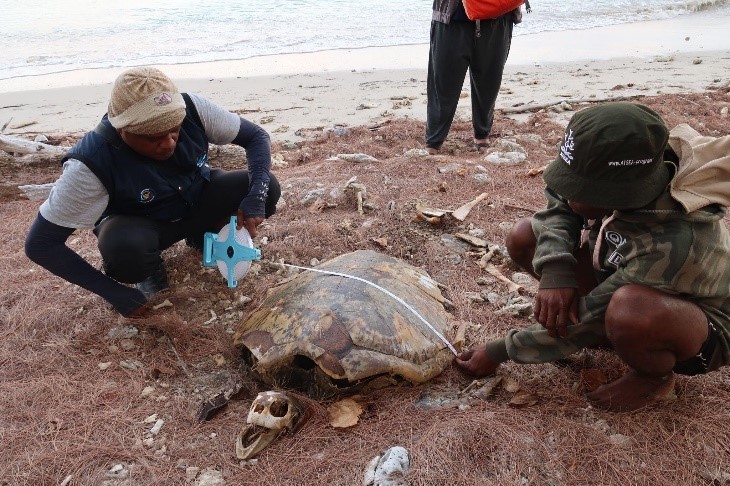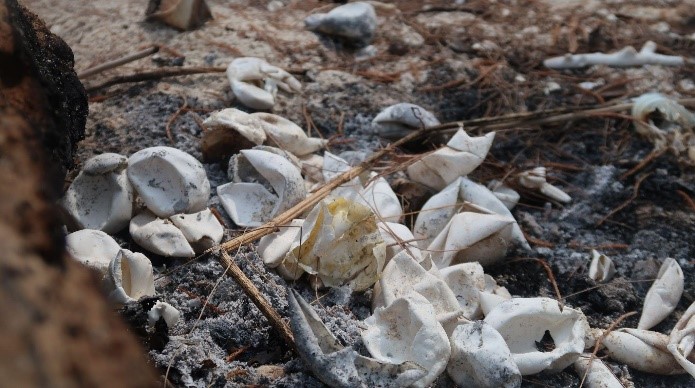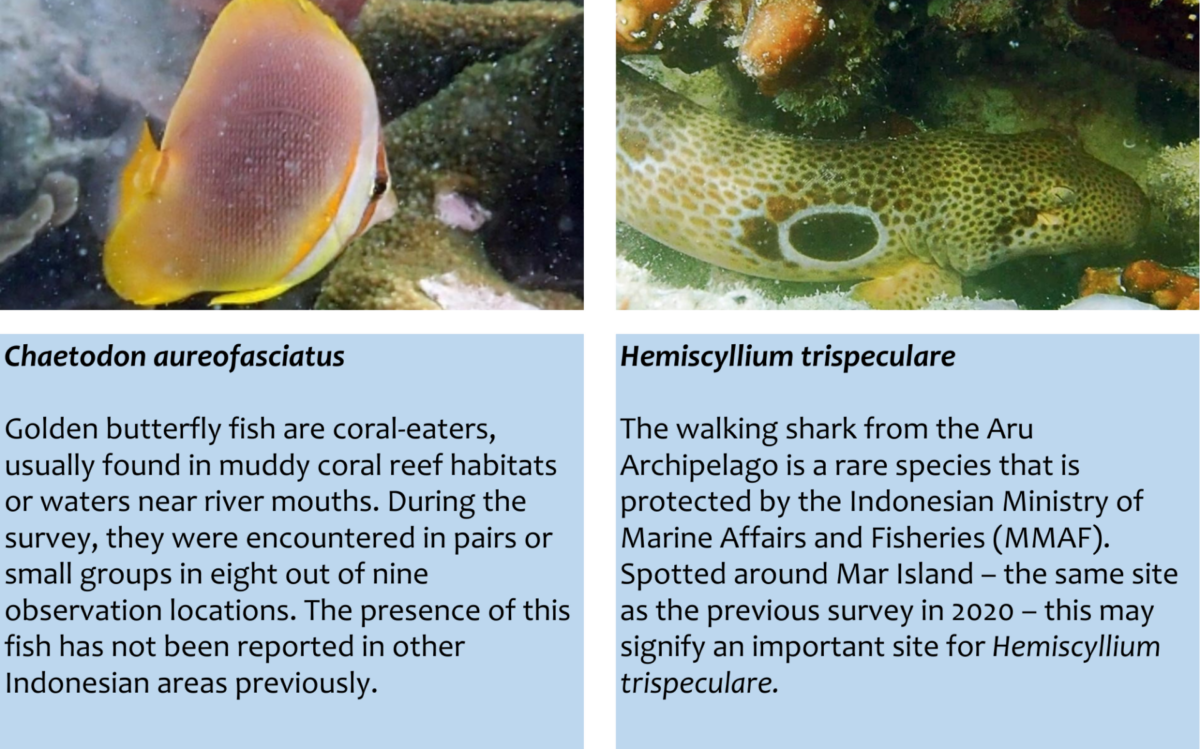In the picturesque Aru Archipelago, the Arafura and Timor Seas Ecosystem Action Phase II (ATSEA-2) team has teamed up with the Southeast Aru Marine Protected Area (MPA) Work Unit, National Marine Conservation Office Kupang (Balai Kawasan Konservasi National Kupang/BKKPN Kupang), and community-led surveillance groups (Kelompok Masyarakat Pengawas/Pokmaswas) to form a dynamic megafauna team. Led by I Made Jaya Ratha, the team, including Christian Frederik Tamaela, Ikrima Avicenna and Dwi Ariyoga Gautama, conducted cetacean and turtle data collection from 1 to 6 November 2023.
The monitoring initiative spanned four major islands within the 115,000-hectare conservation area, part of a routine three-year biophysical program. The objective was to update the ecosystem’s status, measure management effectiveness and assess intervention impacts in the Southeast Aru MPA. The team explored coral reefs, mangroves and seagrasses, studying marine life including sea turtles and Australian humpback dolphins.
Sea turtle monitoring

the carapace of a sea turtle found on the beach, Enu Island
By the dim light of flashlights at 4 a.m. on 1 November, the megafauna monitoring team embarked on their survey activities in the Southeast Aru MPA. The focus was on Enu Island, known for its high conservation value. Due to its vital role in preserving biodiversity, the island has been designated a crucial part of the Aru Southeast MPA. Within a 10 km stretch along the coast, the team encountered 48 turtle tracks and 28 locations for collecting turtle specimens. Subsequent DNA analyses help to assess unique genetic patterns and species connectivity with regions like Australia. This information was combined with other data such as track dimensions and human impact assessments on species sustainability. The results offer insights into the health and sustainability of the marine ecosystem around Enu Island.
This monitoring initiative also shed light on a pressing issue. Human exploitation of turtles remains a significant threat to turtle conservation in the Southeast Aru MPA, with persistent poaching of turtles for both meat and eggs evidenced by the discovery of smoking areas and egg cages. Although Enu Island is uninhabited, temporary residents engage in fishing activities within the conservation area, heightening the risk of turtle exploitation. According to Ramli Lengam, a member of Pokmaswas Gwer Katabar from Apara village in the monitoring team, the continuation of this practice raises concerns about the livelihoods of fishermen in the region.

the consumption of turtle eggs occurred recently
Additionally, the increase of jellyfish in these waters poses a threat to fish fry, emphasising the critical need for turtle protection. Safeguarding turtles goes beyond their well-being; it is integral to ensuring a healthy and flourishing ocean environment. Efforts since 2020 by BKKPN Kupang, the Aru Fisheries Extension Office and the ATSEA-2 team have focused on raising awareness about the importance of sea turtle conservation. Socialisation initiatives focus on reaching out to coastal communities, emphasising the importance of conservation areas for community life and the protection of endangered species. To support monitoring efforts, Pokmaswas groups have been formed in two villages, namely Apara and Karey.
The involvement of the community in sustainable area management and utilisation is expected to reduce threats to turtles and lessen the degradation of marine resources in the Southeast Aru MPA. Investing in community understanding encourages better utilisation patterns. Support from various parties to collaborate with the community on an equal basis in management is a crucial aspect that needs to be promoted in these waters.
Australian humpback dolphins discovery

samples for future DNA analysis
In the serene waters near Jeudin Island, a thrilling encounter unfolded at 10 a.m on the very first day, as two Australian Humpback dolphins (Sousa sahulensis) gracefully emerged from the depths. Another pod, comprising a larger number of individuals, playfully navigated the mangrove estuary. This rare spectacle was captured by the megafauna team.
In a less uplifting encounter with these animals, the team also collected samples of dolphin meat and skeletons during an onshore survey. In addition to dolphins, skeletal remains of whales were found on the four surveyed islands. The species is yet to be confirmed, but the monitoring team took DNA samples to analyse and identify which species had become stranded in this conservation area. DNA-based analysis helps government agencies to better understand where and what species losses are occurring, while also helping to formulate strategies for species conservation efforts.
Dolphins play a crucial role in maintaining marine ecosystem balance. The Southeast Aru MPA ecosystem provides an excellent habitat in which Australian humpback dolphins can nurture their offspring (the dolphins spotted during the monitoring activity were observed with their young). The hope is that effective management of this conservation area will ensure that populations of dolphins continue to visit for many more generations to come.
Rare fish species found
As part of the ongoing biophysical survey of marine resources in the Southeast Aru MPA, a team led by Andreas Muljadi, alongside Ariefianto Tri Mahadi and Respaty Yudha Putranto conducted comprehensive coral reef and reef fish research in the area from 1 to 6 November 2023. The project focused on nine different locations, including Enu Island, Karang Island, Djeudin Island, Manjar Island and Djeh Island. Andreas Muljadi was the leader of the coral reef team and the overall biophysical survey leader, while Ariefianto was the coral reef observer and Respaty assisted in measuring species and coral reef.
The primary objective of the reef fish survey was to identify economically valuable fish groups that can also serve as indicators of coral reef health. In addition, the team meticulously tallied endemic, vulnerable and protected species, paying special attention to specific characteristics such as schooling and spawning aggregation. The team conducted dives at depths of 5-8 metres, swimming along 70-metre transects to monitor and record targeted fish. However, the survey faced significant challenges due to low visibility, which at times was limited to just 3-5 metres. However, the team’s struggles were rewarded when they stumbled upon certain fish species that are rarely or never seen in other conservation areas around Indonesia. There are six unique fish species found during the survey.
The six species are listed below which underscore the importance of effective management in the Southeast Aru MPA. Ensuring the preservation of the area’s life support systems, along with the diversity of its biological resources and their sustainable utilisation, is imperative for the well-being of communities in and around the MPA. From sea turtles and sharks to dolphins and reef fish, ATSEA-2 is working to document, preserve and protect the many species that are central to the health of the Aru Archipelago and the future of its people.



By Dwi Ariyoga Gautama and Andreas Muljadi


